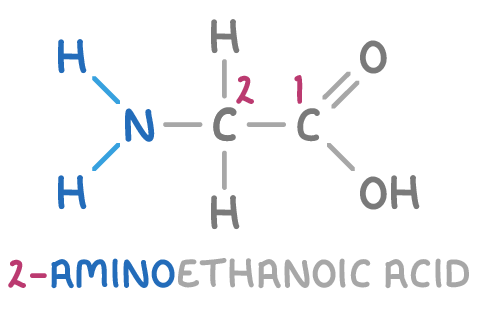Amino Acids
This lesson covers:
- The structure of amino acids
- Naming of amino acids
- Reactions of amino acids
Amino acids contain amine and acid groups
Amino acids consist of both amine and acid functional groups:
- An amino group (-NH2)
- A carboxylic acid group (-COOH)
These groups are attached to the same carbon atom, the α-carbon, in α-amino acids.
The general structure of an α-amino acid is illustrated as:

Here, R denotes a variable organic substituent i.e. an alkyl or aryl group, which is known as the side chain.
Naming amino acids
Amino acids are named using two methods:
- Common names, for example, glycine and alanine
- Systematic IUPAC names, which are based on the carbon backbone
The steps to name an amino acid systematically are:
- Identify the longest carbon chain that includes the carboxyl carbon.
- Start numbering the carbons from the carboxyl carbon, assigning it the number 1.
- Specify the position and identity of the amine substituent.

For example, the systematic name of the amino acid glycine (shown above) is 2-aminoethanoic acid, indicating it has two carbons, with NH2 attached to carbon 2.
Reactions of amino acids
The presence of amine and acid groups in amino acids enables them to participate in various reactions.
Reaction with alkalis:
The carboxyl group can react with aqueous alkalis such as NaOH(aq) to form carboxylate salts and water.

Reaction with acids:
The amine group can react with acids like HCl to form ammonium salts.

Esterification:
The carboxyl group is capable of reacting with alcohols to form esters and water, in a reaction catalysed by concentrated H2SO4.
